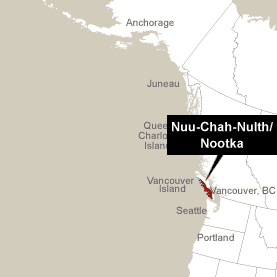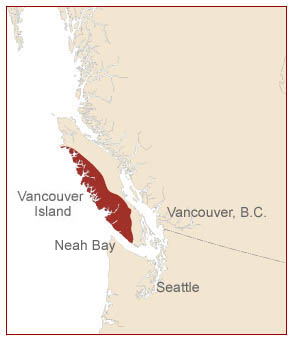
The indigenous people of the West Coast of Vancouver Island call themselves the Nuu-Chah-Nulth, or “all along the mountains”. This title refers to their traditional lands – fertile lands of salmon and cedar stretching from the coastal mountain range to the bountiful waters of the Pacific Ocean.
When landing at Yuquot (Friendly Cove) in 1778, Captain James Cook began referring to the Nuu-Chah-Nulth as “Nootka” after misinterpreting the Mowachahts repeated request for his ship to “travel around the cove”, as the name of the community. Yuquot has yielded rich archaeological evidence that the great whaling nation of the Nuu-Chah-Nulth has inhabited this area for more than 5,000 years.
The Nuu-Chah-Nulth people compose a single cultural group of nineteen different nations, each with their own territory, hereditary chief and distinct dialect. The chief customarily passes possessions – land, names, dances, songs, alliances, privileges, and his material wealth – to the next generation through elaborate ceremonies. Like many other Northwest Coast peoples, the potlatch, a ceremonial celebration to demarcate transference of property or identity, was an integral aspect of Nuu-Chah-Nulth culture that the Nuu-Chah-Nulth people continue to practice today.
For centuries, whale hunting was the primary source of livelihood for the Nuu-Chah-Nulth. The danger of the sea, even in the most sea-worthy canoes, made surviving the hunt with their enormous bounty a tenuous endeavor. The importance of the whale and the whale hunt manifested in every part of Nuu-Chah-Nulth village life. Even the most utilitarian objects became symbols of the hunt, coloring every aspect of life on land. The majority of traditional Nuu-Chah-Nulth stories, myths and songs ask the spiritual powers for help securing a successful whale hunt. Ten moons before a hunt were to commence the whalers initiated rituals of sacrifice, purification and spiritual preparation. These secret purification rites employed sacred charms fashioned from whalebone. One of the most hallowed practices for the Nuu-Chah-Nulth whalers was visiting shrines to commune with spirits of the hunt. Here in these reliquaries the bones of the Pookmis, or lost whaler, rested alongside a cedar plank carved with his likeness. These were places to honor ancestors, friends, and whalers past, imbued with the wisdom of those who previously held this role. Only powerful chiefs had the right to visit the shrines due to the sanctity of the space. In the early 1900’s the most venerated of these shrines, the Yuquot Whaler’s shrine, was removed from the Nuu-Chah-Nulth land by Franz Boaz and now sits in the basement of the American Museum of Natural History in New York City.
 Although Nuu-Chah-Nulth art shares the language of formline art with the Tlingit, Haida, Tsimshian and Kwakwaka’wakw tribes, Nuu-Chah-Nulth three-dimensional sculptures, particularly masks, are unique to the tribe. The Nuu-Chah-Nulth and Makah traditional carvings evolved in a triangular fashion, mimicking the bow of a canoe. Distinctive Nuu-Chah-Nulth characteristics include asymmetrical elements and an illustrative visual lexicon of abstract symbols. The striking profiles of portrait masks display angular patterns featuring specific color and placement that express the owner’s status as well as family and community history. Their famed wolf masks are a manifestation of the secretive Nuu-Chah-Nulth Wolf Society.
Although Nuu-Chah-Nulth art shares the language of formline art with the Tlingit, Haida, Tsimshian and Kwakwaka’wakw tribes, Nuu-Chah-Nulth three-dimensional sculptures, particularly masks, are unique to the tribe. The Nuu-Chah-Nulth and Makah traditional carvings evolved in a triangular fashion, mimicking the bow of a canoe. Distinctive Nuu-Chah-Nulth characteristics include asymmetrical elements and an illustrative visual lexicon of abstract symbols. The striking profiles of portrait masks display angular patterns featuring specific color and placement that express the owner’s status as well as family and community history. Their famed wolf masks are a manifestation of the secretive Nuu-Chah-Nulth Wolf Society.
The icons of the Nuu-Chah-Nulth culture – Whale, Thunderbird, and Lightning Snake – continue to find new voice and expression in the art of Joe David, George David, Moy Sutherland, Patrick Amos and the late Art Thompson.
Copyright © M. Heagle
